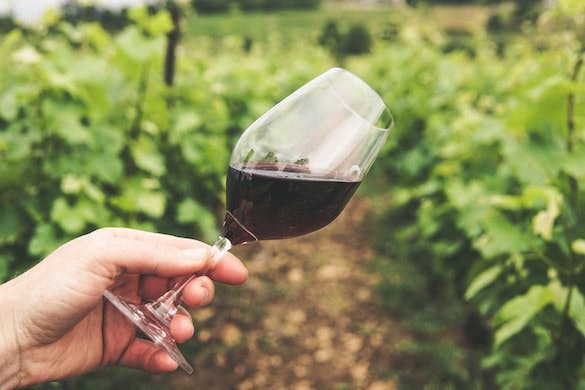Is the Best Red Wine in Austria Actually Hungarian?
The Soviets put the nail in the wine coffin with their collective farming scheme, but a few producers have dedicated themselves to revitalizing the area’s ancient reputation.

Ever since the Romans arrived with their winemaking know-how, the area covering current day eastern Austria and western Hungary have been recognized as prime real estate for quality wine production. For at least 1,000 years, the area now known as Sopron, Hungary, was both its capital and home to its most prized vineyards — but 100 years of mishaps have left those sites and their wines wallowing in obscurity while their western neighbors get all the attention.
Austria, historically, was a producer of renowned sweet wines; now, its white wines from Grüner Veltliner, Riesling, and Sauvignon Blanc, among others, have proven themselves to be of exceptional value, no matter the price point. It has only been in the last 30 years that the reds have garnered any sort of attention. In that short time, thanks to a warming climate, better educated winemakers, greater investment, and changing consumer tastes, Blaufränkisch, especially, is gaining its day in the sun.
Burgenland is the only region within Austria making predominantly red wine. It’s a long, thin swath of land, about a third the size of Bordeaux with a tenth its vineyards. A 45-minute drive southeast of Vienna gets you to the northern edge, just above Lake Neusiedl, down to Styria in the south. Its western flank is the foothills of the Alps and its eastern border, Hungary. Sopron juts into the middle of the region, nicking the bottom of the lake.
Looking at a map, you start to wonder if the Hungarians may have gerrymandered the borders to scoop up the best vineyard land. The truth is in 1921 a plebiscite, or vote of the people, was held to allow citizens to decide which country suited them best. Sopron is now called Hungary’s most loyal city, because even with its majority ethnic German population it was the only area that chose the east.
That vote was the first tip in a domino effect that leads directly to today’s positioning of Hungarian wine on the world market. World War II did not help, of course, with the bombing of the city and the tragic extermination of its Jewish population. After the war, the city voted to expel 3,000 ethnic Germans. This effectively squandered the industry, with no Germans to make wine or Jewish merchants to sell it.
Yet it was the Soviets who put the nail in the wine coffin with their collective farming scheme. Quality vineyards in the hills were abandoned in order to plant in vigorous but poor quality lowland areas. Classic varieties, like Blaufränkisch, a low-yielding, somewhat difficult to farm vine, were grubbed up in favor of workhorse grapes like Olaszrizling (Welschriesling, not to be confused with Riesling). Forced quotas, inexperienced farmers and vintners, and depressed prices meant that in just two generations 2,000 years of wine culture were practically erased.
Not all is lost. A few producers, Hungary’s Peter Wetzer and Austria’s Franz Weninger, especially, have dedicated themselves to revitalizing the area’s ancient reputation.
Franz’s grandmother was born “Hungarian” but Horitschon, their home village, went Austrian with the plebiscite. His father, always suspicious of the West’s characterization of Hungarians as “evil” communists, suspected his neighbors 10 kilometers away couldn’t be that different from those on the “right side” of the iron curtain. He was the first to cross over after the fall of the Berlin wall, and then the first to partner with a Hungarian family in a winery in Villány and, in 1997, the first to buy a vineyard in Sopron with Franz.
Peter Wetzer came from a family who were making wines before the Soviet period. In 2007 he purchased a small collection of vineyards that he’s slowly added to, for a total of 3.5 hectares today. He concentrates on old sites, where the soils were not destroyed by the Cold War-era farming techniques. He doesn’t hold any certification, using biodynamic methods, but even these he only applies if absolutely necessary. Cellar work is the same.
Both estates bought a piece of Spern Steiner, considered Sopron’s very best vineyard. First mentioned in 1680 for its notable wines, they were then taxed at the highest rate in the region (indicating they were the most valuable). Back then, and until phylloxera, the white Furmint was the winning varietal, responsible for sweet Odenburger Ausbruch sold far afield — a rarity in wine at the time, also denoting its quality.
Kekfrankos was the chosen varietal once vineyards were replanted. It does exceptionally well on the gneiss and mica schist soils on the gently sloping, east-facing hill. These examples are taut, sanguine, deep and spicy, with a profile similar to cool climate Syrah but with higher acidity and tannin, like a Nebbiolo. Wetzer and Weninger have also replanted some Furmint, which shows a golden apple, honey, and waxy character on these darker soils.
It is not just wines from the famous vineyard that are worth seeking out. Weninger’s Rózsa Petsovits, mentioned last week as my other favorite rosé (okay, it’s actually my favorite), is a blend of Syrah that they planted in 1997 with Zweigelt, Blaufränkisch, and Pinot Noir from Austria. It’s a stunning $20 wine, with tensile grip, tart raspberry, orange sherbet, stoney, spicy palate, and a long, mineral finish.
Until last night, I would have said that Weninger’s Balf Kekfrankos was one of the greatest deals in red wine from anywhere. Then I drank a bottle of Wetzer’s Kekfrankos, which may just be the best $20 wine I’ve ever had. They are village wines, blended from multiple sites, without the aging potential of the top wines but bursting with levity, making them much more enjoyable in their youth. The Wetzer took a few hours to really open up, indicating it may actually develop into something greater in the years to come, but I don’t think anyone would want to wait to find out, it was just so darn delicious.
Of course, as with many of the best wines out there, availability on Wetzer is scarce. Weninger on the other hand, while slightly obscure, is usually findable with a bit of an internet search.
These days Austria is ahead in the red wine game. Producers there have the resources to cultivate and craft some of the world’s great (if not wholly underappreciated) red wines. But if more of them follow in the steps of Wetzer, and learn from their expat neighbors like Weninger, the Sopron, at least, will be giving its western neighbor a run for its money in no time.

